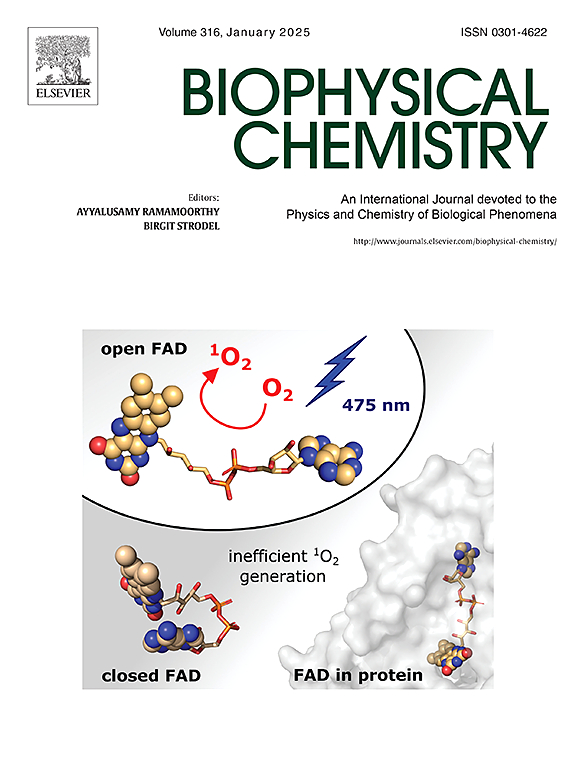在硅和体外鉴定的植物latbenia (Moq.): QSAR,植物化学和毒理学的见解降糖和降糖的潜力
IF 2.2
3区 生物学
Q2 BIOCHEMISTRY & MOLECULAR BIOLOGY
引用次数: 0
摘要
糖尿病及相关合并症与晚期糖基化终产物(AGEs)水平升高有关。晚期糖基化的生化过程被认为在并发症的发生中起着关键作用。由于天然产物具有很大的抗糖尿病潜力,我们研究了植物的晚期糖基化抑制和抗糖尿病特征。基于QSAR和分子对接分析的馏分和分选化合物。前两种生物活性化合物;山奈酚和Esculentoside G在运行150 ns时与标准对照,进一步评估MD模拟研究。在所测试的化合物中,山奈酚在MM-GBSA中表现出显著的结合能(- 48.63 Kcal/mol),与转录调节剂4F5S的MD模拟研究(73%)。分子对接研究表明山母酚与4F5S蛋白的Trp213和Arg217残基形成了Pi-Pi堆叠和pi -阳离子相互作用,并与Val342、Ser343和Ser453形成了3个氢键。山奈酚对α-葡萄糖苷酶的抑制作用(IC50为0.042±2.31 μg/ml)显著高于阿卡波糖(IC50为0.036±0.31 μg/ml)。几乎所有选定的化合物都符合ADMET调查确定的安全要求。用极性递增的溶剂对粗甲醇提取物进行液液分配,得到5个溶剂馏分;用乙酸乙酯和水对粗提取物进行液-液分配得到的乙酸乙酯部分(ETOA)在非氧化(61%)和氧化(58%)抗糖基化试验中对硫醇基团的估计都有实质性的结果。乙酯组分(ETOA)显示出较强的抗氧化活性,通过DPPH测定,IC₅₀值为13.25±0.69 μg/ml。α-葡萄糖苷酶实验中,水溶液组分的IC50值为0.108±0.32 μg/ml,而标准品的IC50值为0.083±0.43 μg/ml。安全性评估显示,与对照组相比,在24小时内,HeLa细胞存活率从2.5%浓度的82%下降到10%浓度的69%。因此,Phytolacca latbenia (Moq)。经测试,其植物化合物可抑制α-葡萄糖苷酶和晚期糖基化终产物——这一过程是糖尿病并发症的基础,因此作为治疗糖尿病及相关合并症的无毒性药物具有很大的前景。本文章由计算机程序翻译,如有差异,请以英文原文为准。

In silico and in vitro characterization of Phytolacca latbenia (Moq.): QSAR, phytochemical, and toxicological insights into antiglycation and antidiabetic potential
Diabetes and the related comorbidities have been associated with elevated levels of advanced glycation end products (AGEs). The biochemical process of advanced glycation, is believed to be playing a pivotal role in the development of complications. Since there exists a great deal of promise for natural products offering antidiabetic potential, we studied advanced glycation inhibition and anti-diabetic profile of Phytolacca latbenia (Moq). on fractions and the sorted compounds based on the QSAR and molecular docking analysis. The top two bioactive compounds; Kaempferol and Esculentoside G, were further evaluated for the MD simulation studies at 150 ns run, compared with the standard. Among the tested compounds, Kaempferol presented significant binding energies in MM-GBSA (−48.63 Kcal/mol) and MD simulation studies (73 %) with transcriptional regulator 4F5S. Molecular docking studies revealed that kaempferol formed three hydrogen bonds with Val342, Ser343 and Ser453, along with Pi-Pi stacking and Pi-cation interactions with Trp213 and Arg217 residues of the 4F5S protein. Kaempferol also displayed significant α-glucosidase inhibition (IC50 0.042 ± 2.31 μg/ml) compared to the acarbose (IC50 0.036 ± 0.31 μg/ml). Almost all of the selected compounds demonstrated adherence to the safety requirements established by ADMET investigation. Liquid–liquid partitioning of the crude methanolic extract with solvents of increasing polarity yielded five solvent fractions;the ethyl acetate fraction (ETOA) obtained by liquid–liquid partitioning of the crude extract with ethyl acetate and water proclaimed substantial results in both the non-oxidative (61 %) and oxidative (58 %) antiglycation assays for thiol group estimation. The ethylacetae fraction (ETOA) demonstrated comparatively strong antioxidant activity, with an IC₅₀ value of 13.25 ± 0.69 μg/ml as determined by the DPPH assay. In α-glucosidase assay, Aqueous fraction demonstrated a considerable inhibition with IC50 value of 0.108 ± 0.32 μg /ml compared to the standard (IC50 0.083 ± 0.43 μg/ml). The safety assessment revealed a slight decline in HeLa cell viability, dropping from 82 % at a 2.5 % concentration to 69 % at a 10 % concentration over 24 h, relative to the control.Therefore, Phytolacca latbenia (Moq). and its phytocompounds tested inhibit α-glucosidase and Advanced glycation end product-the process that underlie diabetic complications and may therefore holds great promise as therapeutic agent, with no toxicity concern,against diabetes and related comorbidities.
求助全文
通过发布文献求助,成功后即可免费获取论文全文。
去求助
来源期刊

Biophysical chemistry
生物-生化与分子生物学
CiteScore
6.10
自引率
10.50%
发文量
121
审稿时长
20 days
期刊介绍:
Biophysical Chemistry publishes original work and reviews in the areas of chemistry and physics directly impacting biological phenomena. Quantitative analysis of the properties of biological macromolecules, biologically active molecules, macromolecular assemblies and cell components in terms of kinetics, thermodynamics, spatio-temporal organization, NMR and X-ray structural biology, as well as single-molecule detection represent a major focus of the journal. Theoretical and computational treatments of biomacromolecular systems, macromolecular interactions, regulatory control and systems biology are also of interest to the journal.
 求助内容:
求助内容: 应助结果提醒方式:
应助结果提醒方式:


